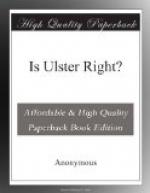A strong party, however, led by Lord Clare were in favour of clemency wherever possible; and there seemed good reason for hoping that the rebellion would slowly die out. Cooke, the Under Secretary, wrote on the 9th of August: “The country is by no means settled nor secure should the French land, but I think secure if they do not.” Suddenly, however, the alarming news came that the French were actually in Ireland. Wolfe Tone and his fellow-plotters, undaunted by their previous failures, had continued ceaseless in their efforts to induce Napoleon to make an indirect attack on England by invading Ireland; and if they had succeeded in persuading the French Government to send an expedition two months earlier when the rebellion was at its height and the English reinforcements had not arrived, Ireland must have been lost. Once again, however, fortune favoured the English cause. The first instalment of the French fleet, carrying 1,000 soldiers, did not start until the 6th of August, and only arrived on the 22nd. They landed at Killala, in Mayo, and were not a little surprised at the state of things existing there. They had expected to find a universal feeling of republicanism; but instead of this, whilst the Protestants refused to join them, the Roman Catholic peasantry received them with delight, and declared their readiness to take arms for France and the Blessed Virgin. “God help these simpletons,” said one of the officers, “if they knew how little we care about the Pope or his religion, they would not be so hot in expecting help from us!”
Arriving at the wrong time and the wrong place, the expedition was foredoomed to failure. The French were brave men and trained soldiers; but they found their Irish allies perfectly useless. They succeeded in capturing Castlebar, and routing a force of militia; but their campaign was brief; on the 8th of September the whole force surrendered. The Connaught rebellion was speedily and severely put down.
The second instalment of the French invasion consisted of one ship. They landed on the Island of Arran on the 16th of September; but after spending eight hours on shore, re-embarked and sailed away to Norway.
The third instalment was, however, more serious. It consisted of a ship of the line, eight frigates and a schooner, having on board an army of about 3,000 men. They arrived at Lough Swilly early in October, where they were met by a more powerful English fleet, and nearly all were destroyed or captured. Amongst the prisoners taken was Wolfe Tone; who soon afterwards in order to avoid a felon’s death, ended his life by suicide.[See note at the end of the Volume]
A fortnight later the fourth and last instalment arrived at Killala Bay; but the Admiral, hearing that the rebellion was over, promptly weighed anchor and returned to France. Thus ingloriously ended the French attempts at the invasion of Ireland. The calling-in of the foreigner had been of as little use to the cause of Irish rebellion as it had been two centuries before.




